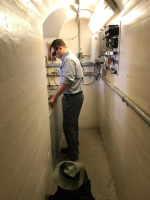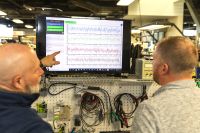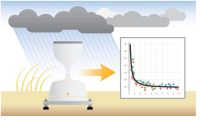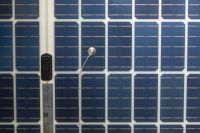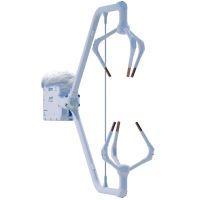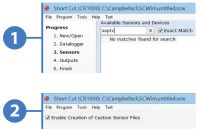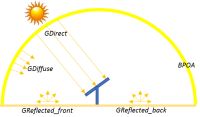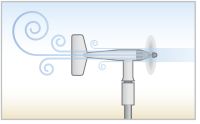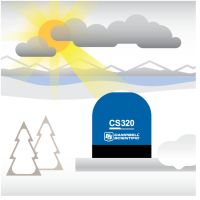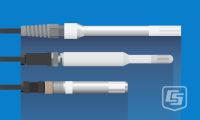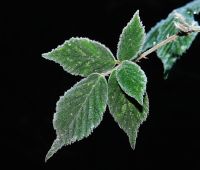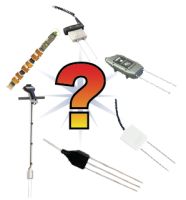Sensor Topics Your source for sensor-related articles
Displaying 1 - 20 of 26 articles
How to Easily Replace and Update a CS223 Sensor Head
Autor: Ajay Singh | Última actualización: 01/15/2024 | Comentarios: 0
Campbell Scientific’s CS223 Pt-1000 Class A, Back-of-Module Temperature Sensor (discontinued effective 31 October 2023) has been replaced by the CS241 Pt-1000 Class A, Back-of-Module Temperature Sensor. When needed, you can replace the CS223 sensor head with a CS241 head without having to replace the entire... leer másHow the DustVue Can Help You Get USABLE Soiling Data
Autor: Ben Todt | Última actualización: 12/04/2023 | Comentarios: 0
Should you be concerned about the impact of soiling or fouling on your photovoltaic (PV) power plant performance? Did you know that in a recent estimate, more than US$6 billion of annual revenue is lost because of diminished power generation at PV facilities due to... leer másUso de VSPECT® para verificar cuerda vibrante: ¿sensor estropeado o datos erróneos?
Autor: Jacqalyn Maughan | Última actualización: 04/06/2023 | Comentarios: 0
Have you ever thought your bad vibrating wire sensor measurements were caused by erratic or erroneous data? You may be surprised to learn that data issues may not be the cause. If you are using a data-acquisition system other than one of the Campbell Scientific... leer másTroubleshooting Vibrating Wire Piezometers
Autor: Nathanael Wright | Última actualización: 03/28/2023 | Comentarios: 0
Campbell Scientific vibrating wire measurement hardware, with our patented VSPECT® technology, offers a distinct advantage over all other vibrating wire measurement systems. Unlike non-Campbell Scientific vibrating wire interfaces that use pulse counting to derive vibrating wire frequency, Campbell Scientific's VSPECT vibrating wire measurement products use spectral... leer másWhy Do We Need an Algorithm for Rainfall Intensity Correction?
Autor: Dirk Baker | Última actualización: 03/05/2021 | Comentarios: 0
In this article, I’ll explain how errors can occur when measuring the precipitation amount, discuss a correction approach, and demonstrate how an algorithm can be used to design high-quality tipping bucket rain gauges. Introduction Liquid precipitation (rain) is at once one of the simplest measurements mechanically and... leer másMonitoring the Performance of Bifacial Solar PV Panels: Challenges and Opportunity
Autor: Ajay Singh | Última actualización: 10/13/2020 | Comentarios: 0
When we are faced with challenges, there is often an opportunity for improvement. In this blog article, learn how our engineers redesigned our back-of-module (BOM) temperature sensor to resolve specific challenges that impacted the quality of bifacial solar photovoltaic (PV) panel performance monitoring. Bifacial PV panels... leer másEvolución, no revolución: actualización de gama sensores T/HR aire
Autor: Andrew Sandford | Última actualización: 01/06/2020 | Comentarios: 0
Imagine that you already have a winning sensor that has sold more than 15,000 units. As time passes, you realize that technology has evolved, but your sensor hasn’t. If you are objective in your product evaluation, you may determine that there is justification for the... leer másWhy Should You Use a Heated Sonic Anemometer?
Autor: Robin Deissinger | Última actualización: 11/19/2019 | Comentarios: 0
Are you ready to get heated? In this interview, Hayden Mahan, Product Manager of the Gas Flux and Turbulence Group, shares his excitement about our heated sonic anemometer (the new CSAT3BH) and why heat matters. Hayden was interviewed by Robin Deissinger, the blog editor. Interview... leer másToma de medidas en perfil de suelo in-situ
Autor: Dirk Baker | Última actualización: 04/17/2019 | Comentarios: 0
Advances in technology and mechanical design offer vast improvements for those of you who need soil measurements at multiple depths—especially environmental researchers and anyone who works with environmental monitoring networks. In this article, we’ll take a closer look at the measurement challenges you may face... leer másCrear plantillas de sensores personalizados en Short Cut
Autor: Jason Ritter | Última actualización: 02/27/2019 | Comentarios: 4
Have you ever wanted Short Cut to support more sensors? Although Short Cut supports many sensors, you may have found that the sensor you want to measure is not on the list. What do you do then? How do you add that sensor to your... leer másNew Product Support: Bifacial Plane of Array (BPOA), solar energy’s newest irradiance expression
Autor: Matt Perry | Última actualización: 12/12/2018 | Comentarios: 1
Plane of array irradiance (POA) is a well-known term used to quantify the incident irradiance on a given solar array. It is the parameter most directly related to the power output of a PV module and is used extensively in PV performance analysis and modeling... leer másClimaVUE50 - estación meteo todo en uno, simplicidad y buenas medidas
Autor: Robin Deissinger | Última actualización: 10/17/2018 | Comentarios: 2
Can a simplified weather station solution still provide you with good measurements? In this interview, Alan Hinckley, Senior Application Scientist-Meteorologist, shares his excitement for the ClimaVue™50 and how users of various backgrounds can benefit from its simplicity in capturing quality weather data. Alan was interviewed... leer másA Safer Solution to Scrub Agents from Campbell Scientific Gas Analyzers
Autor: Ben Conrad | Última actualización: 06/25/2018 | Comentarios: 0
If you have an eddy-covariance system, you understand the importance of performing routine maintenance tasks so you can continue to acquire high-quality, consistently reliable data. Some of these maintenance tasks are straightforward, such as making sure that the optics on your gas analyzer are clean... leer másWhy Do Variable Wind Speed Readings Occur with a Constant Wind?
Autor: Jacob Davis | Última actualización: 01/31/2018 | Comentarios: 4
At some point, you may have watched the real-time wind readings from your data logger and seen the wind speed bouncing back and forth. Then, you probably wondered if it really was that gusty outside. In many cases, what you are seeing is the resolution... leer másSensor de radiación solar global preciso y simple - de termopilas y con SDI-12
Autor: Chod Stephens | Última actualización: 09/13/2017 | Comentarios: 4
To help environmental researchers who measure solar radiation improve their measurements and simplify their lives, Campbell Scientific and Apogee Instruments teamed up to develop a new sensor. This new sensor combines features from higher-end blackbody thermopile pyranometers and lower-end silicon photocell pyranometers. The CS320 Digital Thermopile... leer másPiranómetros: lo que hay que saber
Autor: Alan Hinckley | Última actualización: 06/14/2017 | Comentarios: 13
If you are considering using pyranometers in your measurement application, there are many things you should know about them and how they work. Having this information in hand will help ensure you select the type of pyranometer most suitable for the data you need for... leer másSensores de temperatura y humedad relativa del aire: lo que hay que saber
Autor: Bart Nef | Última actualización: 05/17/2017 | Comentarios: 8
Although air temperature and relative humidity (RH) sensors provide the benefit of an economical means to collect measurement data for two parameters, there are some issues related to these sensors that you should be aware of. In this article, I’ll provide some background on air... leer másEscarcha - minimizar las pérdidas económicas haciendo medidas directas
Autor: Dirk Baker | Última actualización: 02/08/2017 | Comentarios: 0
Are you concerned about frost damage to your crops? There are a number of high-value crops that are critically vulnerable to frost damage. Especially on buds, flowers, and early fruit, frost can cost growers thousands of dollars per acre. For a long time, many growers have monitored... leer másThe Most Rugged Air Temp/RH Sensor We Know of: the EE181
Autor: Robin Deissinger | Última actualización: 12/14/2016 | Comentarios: 0
In this interview, Chod Stephens, the product manager for the new EE181-L, tells us why this new sensor is ideal for Campbell Scientific customers with deployment sites in extreme environments. Chod is the Technical Product Manager for the Environmental Group at Campbell Scientific, Inc. He... leer másEscoger el mejor sensor para medida del contenido de agua en suelo
Autor: Jason Ritter | Última actualización: 07/06/2016 | Comentarios: 4
Because there are many different types of soil water content sensors available, choosing the best one for your application may seem difficult or even confusing. To help you make your selection, it’s important to understand what soil water content sensors actually measure, what makes a... leer más

